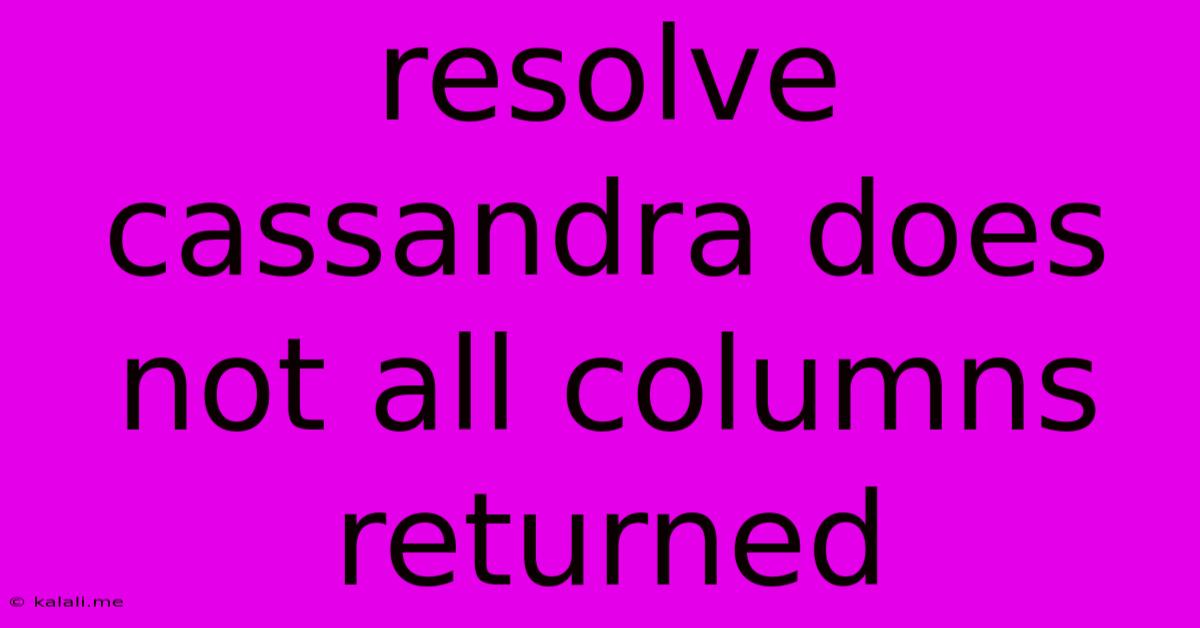Resolve Cassandra Does Not All Columns Returned
Kalali
May 26, 2025 · 4 min read

Table of Contents
Resolve "Cassandra Does Not Return All Columns"
Cassandra's efficiency stems from its column-oriented nature. However, this can sometimes lead to the frustrating "Cassandra does not return all columns" error. This article delves into the common causes of this issue and provides practical solutions to help you retrieve all the data you need from your Cassandra tables. Understanding the intricacies of Cassandra's data model and query execution is key to resolving this problem.
Understanding the Problem: The core issue lies in how Cassandra retrieves data. It doesn't fetch all columns by default; instead, it returns only the columns explicitly specified in your SELECT statement. This is a deliberate design choice for optimization, improving query performance, especially with wide tables. Omitting columns from your query unintentionally is the most frequent reason for incomplete data retrieval.
Common Causes and Solutions:
1. Incorrect SELECT Statement: This is the most common culprit. Double-check your SELECT statement to ensure you've included all the columns you intend to retrieve. Forgetting even a single column will lead to incomplete results.
- Problem:
SELECT column1, column3 FROM mytable;(column2 is missing) - Solution:
SELECT column1, column2, column3 FROM mytable;Or, for simplicity and to retrieve all columns, useSELECT * FROM mytable;However, remember that usingSELECT *might be less efficient for large tables.
2. Data Modeling Issues: Your Cassandra table's design might inadvertently contribute to the problem.
- Problem: Improperly defined columns, particularly with complex data types or nested structures, can lead to unexpected behavior. Incorrectly using collections (sets, lists, maps) can also affect the way data is retrieved.
- Solution: Review your table schema carefully. Ensure that all your columns are correctly defined and that you understand how data is structured within collections. Use appropriate data types for optimal performance and readability. Consider whether you need to denormalize your data to efficiently retrieve related information.
3. Insufficient Permissions: Check the access rights for the user executing the query.
- Problem: The user may lack the necessary privileges to access all columns in the table.
- Solution: Grant appropriate permissions to the user. Use the
GRANTstatement in Cassandra's CQL (Cassandra Query Language) to provide the necessary access rights. Ensure the user has theSELECTprivilege on the specified table and columns.
4. Driver Issues: Problems with the Cassandra driver you're using can occasionally interfere with data retrieval.
- Problem: Outdated drivers or driver configuration issues can prevent the correct retrieval of all columns.
- Solution: Update your Cassandra driver to the latest version. Review the driver's configuration settings and documentation to identify any possible problems.
5. Data Consistency Issues: In rare cases, inconsistencies within the Cassandra cluster itself could be the root cause.
- Problem: Data replication issues or inconsistencies between nodes can sometimes lead to the appearance of missing columns.
- Solution: Verify that your Cassandra cluster is functioning correctly. Use
nodetool statusto check the health of your nodes. Examine cluster logs for any errors that could be contributing to data inconsistencies. Consider usingnodetool repairto resolve any potential data inconsistencies.
6. Filtering and WHERE Clauses: Overly restrictive WHERE clauses might unintentionally filter out columns, creating the illusion of missing data.
- Problem: A
WHEREclause that's too specific might exclude rows containing the columns you're expecting. - Solution: Carefully review your
WHEREclause to ensure it's not inadvertently filtering out data. Check theWHEREclause syntax and the data it's filtering against.
Best Practices for Avoiding This Issue:
- Explicitly list all columns: Always explicitly list the columns you need in your
SELECTstatement, even if it seems redundant. This leaves no room for error. - Regular schema review: Periodically review your table schemas. Adjust and optimize them as your data requirements change.
- Use appropriate data types: Choose the correct data types to avoid unexpected data behavior.
- Test thoroughly: Rigorously test your queries to ensure you're retrieving all expected data before deploying them to production.
- Monitor your cluster: Regularly monitor your Cassandra cluster's health and performance to quickly identify and address potential data issues.
By understanding these causes and implementing the recommended solutions, you can effectively resolve the "Cassandra does not return all columns" error and ensure the integrity of your data retrieval processes. Remember to always prioritize clear, concise, and well-tested queries to prevent similar issues in the future.
Latest Posts
Latest Posts
-
How To Say My Love In Spanish
May 27, 2025
-
Error Unexpected Method Appcast Called On Cask Adoptopenjdk11
May 27, 2025
-
Lucifer Was The Angel Of Music
May 27, 2025
-
See You In The Funny Papers Meaning
May 27, 2025
-
How To Get Rust Out Of Clothing
May 27, 2025
Related Post
Thank you for visiting our website which covers about Resolve Cassandra Does Not All Columns Returned . We hope the information provided has been useful to you. Feel free to contact us if you have any questions or need further assistance. See you next time and don't miss to bookmark.